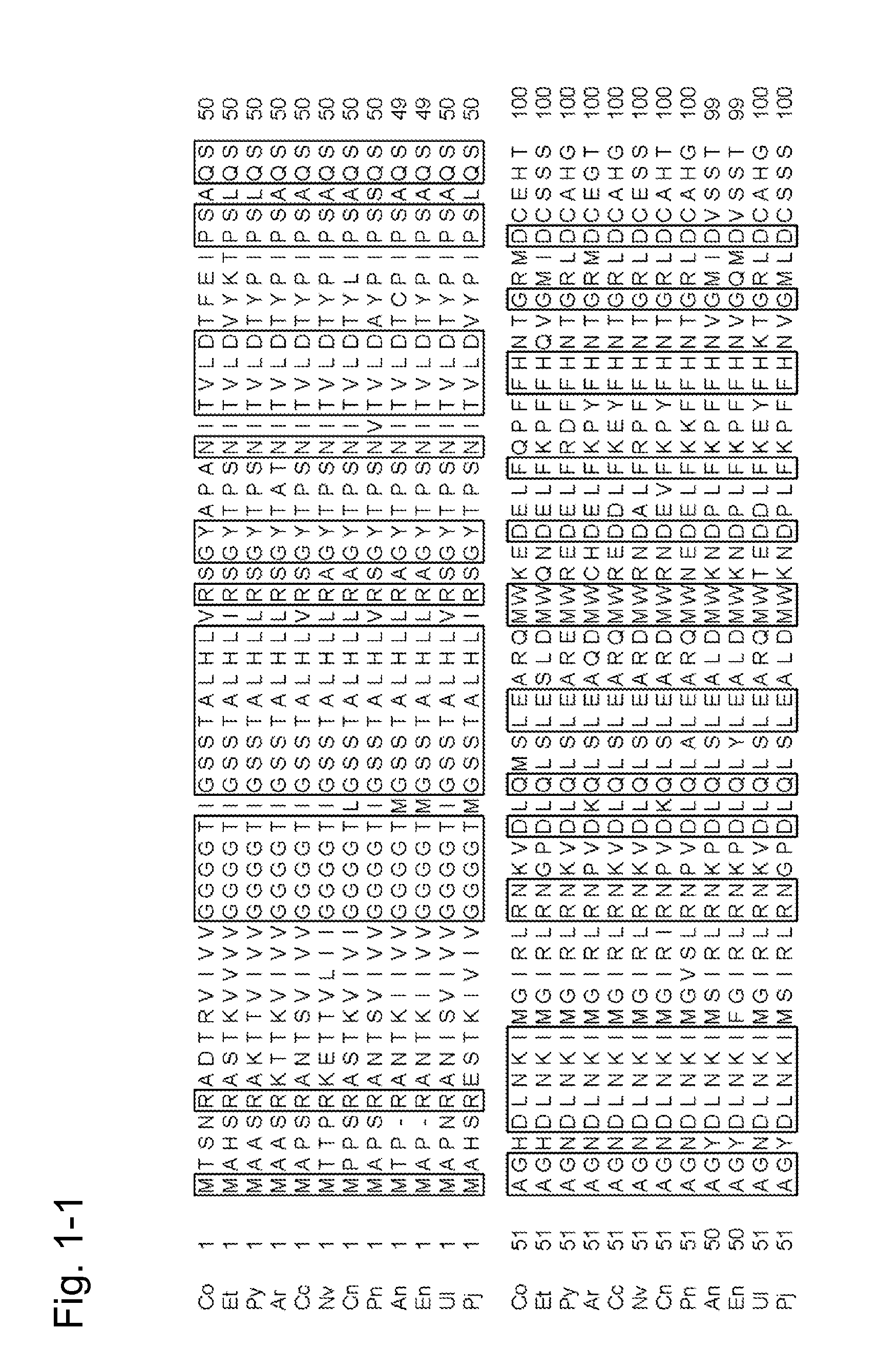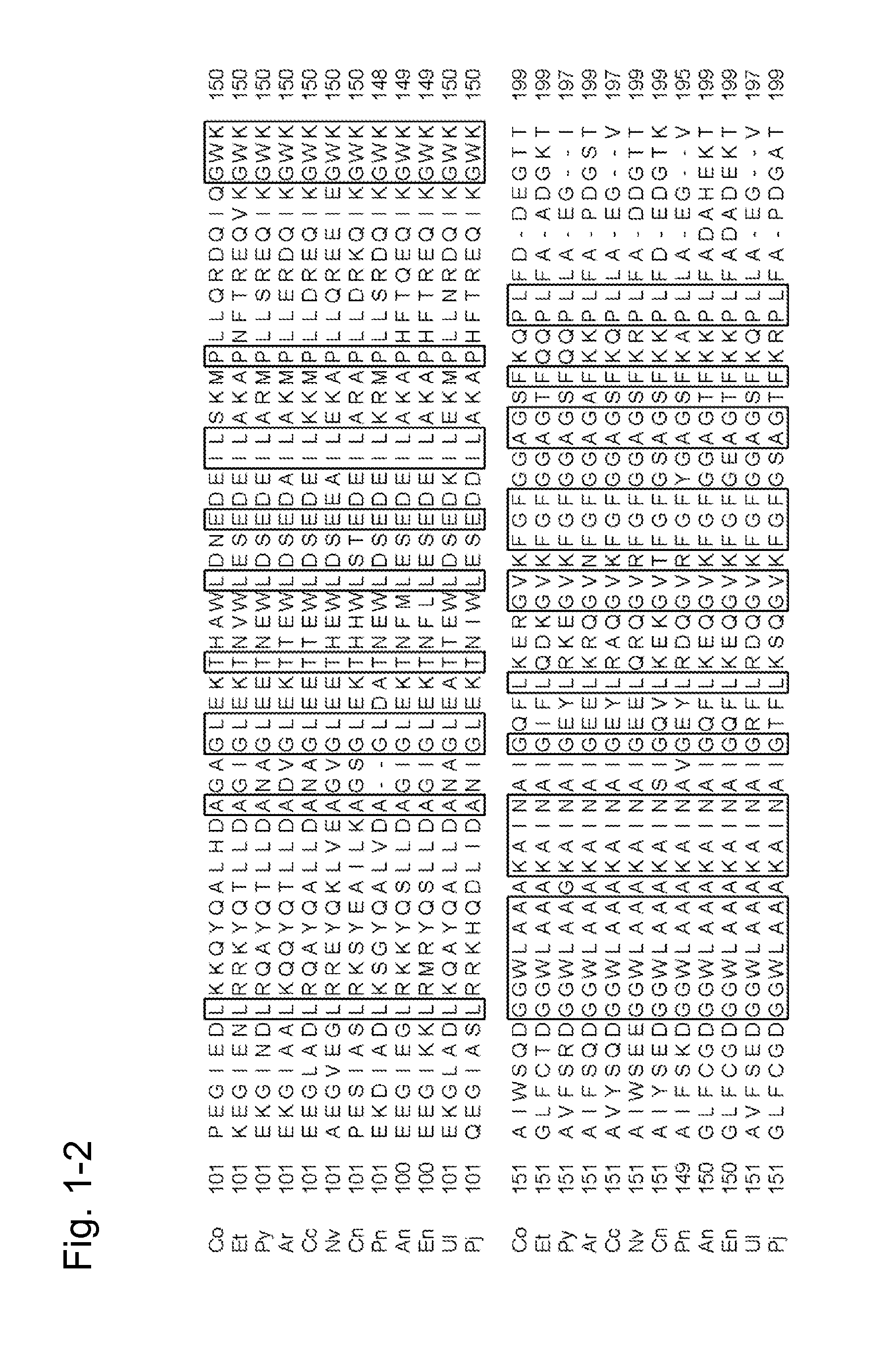Modified amadoriase reacting with fructosyl hexapeptide
a technology of fructosyl hexapeptide and amadoriase, which is applied in the field of amadoriase reacting with fructosyl hexapeptide, can solve the problems of disadvantageous cleavage of contaminants, difficulty in quantification, and inability to detect the method, so as to achieve satisfactory quantification of f6p, the effect of simple, fast and accura
- Summary
- Abstract
- Description
- Claims
- Application Information
AI Technical Summary
Benefits of technology
Problems solved by technology
Method used
Image
Examples
example 1
(1) Preparation of DNA of Recombinant Plasmid pKK223-3-CFP-T7
[0360]A strain of E. coli JM109 (pKK223-3-CFP-T7) having the recombinant plasmid of an amadoriase gene derived from the genus Coniochaeta (SEQ ID NO: 2) (WO 2007 / 125779) was inoculated into 3 ml of LB-amp media (1% (w / v) bactotrypton, 0.5% (w / v) peptone, 0.5% (w / v) NaCl, and 50 μg / ml ampicillin) and shake culture was conducted at 37° C. for 16 hours to obtain a culture product.
[0361]The culture product was centrifuged at 10,000×g for 1 minute to collect strains. A recombinant plasmid pKK223-3-CFP-T7 was extracted and purified therefrom using the GenElute Plasmid Mini-Prep Kit (manufactured by Sigma-Aldrich Corporation), and 2.5 μl of DNA of the recombinant plasmid pKK223-3-CFP-T7 was obtained. (2) Site-directed modification operation of DNA of recombinant plasmid pKK223-3-CFP-T7
[0362]PCR was carried out under conditions described below using DNA of the recombinant plasmid pKK223-3-CFP-T7 as a template, synthetic oligonucle...
example 2
Production and Purification of Various Types of Amadoriases
[0407](Production and Purification of Modified Amadoriase Derived from the Genus Coniochaeta)
[0408]Wild-type amadoriases derived from the genus Coniochaeta and the strains of E. coli JM109 (pKK223-3-CFP-T7), E. coli JM109 (pKK223-3-CFP-T7-62D), E. coli JM109 (pKK223-3-CFP-T7-H20), E. coli JM109 (pKK223-3-CFP-T7-H21), and E. coli JM109 (pKK223-3-CFP-T7-H35) producing modified amadoriases obtained in the manner described above were inoculated into 120 ml of LB-amp media supplemented with IPTG (final concentration: 0.1 mM) and cultured therein at 25° C. for 16 hours. The resulting cultured strains were washed with a 10 mM potassium phosphate buffer (pH 7.0), the washed strains were suspended in the same buffer, the resulting suspension was ultrasonically disintegrated, and the resultant was centrifuged at 20,000×g for 10 minutes to prepare 24 ml of a crude enzyme solution.
[0409]The prepared crude enzyme solution was allowed to ...
example 3
Introduction of Point Mutations into Various Amadoriases
[0426]The finding of the present invention was first examined with the use of the amadoriase derived from the genus Coniochaeta. The results can suggest that similar effects can be expected by introducing a similar mutation into a corresponding position in the amino acid sequence of the amadoriase derived from another organism species with reference to the information attained by a known sequence alignment processing based on sequence identity. Accordingly, the finding of the present invention was actually applied to a plurality of amadoriases other than the amadoriase derived from the genus Coniochaeta in an attempt of verification of such suggestion.
1. Introduction of Point Mutation into Gene of Fructosyl Peptide Oxidase Derived from Eupenicillium terrenum
[0427]SEQ ID NO: 40 shows the amino acid sequence of fructosyl peptide oxidase derived from Eupenicillium terrenum (hereafter referred to as “EFP-T5”), and it can be prepar...
PUM
| Property | Measurement | Unit |
|---|---|---|
| pH | aaaaa | aaaaa |
| pH | aaaaa | aaaaa |
| pH | aaaaa | aaaaa |
Abstract
Description
Claims
Application Information
 Login to View More
Login to View More - R&D
- Intellectual Property
- Life Sciences
- Materials
- Tech Scout
- Unparalleled Data Quality
- Higher Quality Content
- 60% Fewer Hallucinations
Browse by: Latest US Patents, China's latest patents, Technical Efficacy Thesaurus, Application Domain, Technology Topic, Popular Technical Reports.
© 2025 PatSnap. All rights reserved.Legal|Privacy policy|Modern Slavery Act Transparency Statement|Sitemap|About US| Contact US: help@patsnap.com



